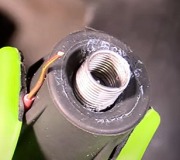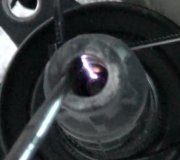I have a 1988 Toyota Corolla SR-5 with a 4A-F carburated engine. 185,000 miles. Allow me to start from the beginning.
I took some precautions a year ago in preparation for a California smog check by replacing the distributor cap and wires, (the plug wires come built in to the cap for this model), rotor, plugs, air filter and oil.
One morning, six months later, the car just wouldn't start, yet she cranked heartily. I smelled gas so I suspected, and verified, a spark problem. Plugs looked like new. I removed the distributor cap and noticed a semi hard gray residue buildup of some kind on the internal contacts of the cap. It flaked right off. Yippee, fires right up!
Two weeks later, same thing happens, and is corrected the same way. Then the no start condition begins to reoccur more and more frequently. So I just go ahead and buy another cap/wires and rotor. No problem for about a month but then it happens again. And then again and again. Now cleaning the contacts doesn't seem to be of any help. It won't start sometimes. It's unpredictable. But when it does happen, if I let the car sit for 45 minutes or more, it fires right up. Well, usually. Bought yet another cap/wire set and rotor, but from a different parts house instead of the discount parts store.(Ya get what ya pay for?). Checked plug condition again and they look great on all four.
So now buying new distributor components doesn't solve the problem anymore. In fact it's sputtered and died while going down the road. Now cleaning the cap and rotor contact points are to no avail. After 45 minutes or so it eventually restarts. Well, usually. It does seem to be prone to act up after warm up and on days over 95 degrees.
According to my Haynes manual the coil's secondary resistance is in within range of specifications. HOWEVER, the primary resistance is spec'ed to be between 1.3 to 1.5 ohms.I got 1.6 using a good digital meter. Is that really far enough out of range to be a possible cause? The cetrifugal govenor plates seem to move okay. In your experience, can the igniter, coil or pick up coil be affected by heat, act sporadically, or do they just go bad and that's that?
Also, I did the diagnostic computer check described in my manual, putting a jumper wire to bridge terminals "T" and "E1" on the diagnostic block, then counting the number of times the check engine light flashes and comparing it to the trouble code chart. I got one flash, pause, then two indicating a "code 12" for R.P.M. Signal. The manual's diagnosis is "No 'NE' signal to the ECU within two seconds after the engine is cranked and/or no 'G' signal to the ECU two two times in succession when engine speed is between 500 rpm and 4000 rpm".
(Now I'm scratching my head thinking, "HUH?") The trouble code chart next shows the trouble areas to look: distributor circuit, distributor, starter signal circuit, igniter circuit, igniter and finally the ECU micro computer for carburetor feedback.
That's a pretty wide field of potential problems. Before, I would just throw money at the problem until I got it, but my current financial condition does not permit me to do this. If anyone could help me with any educated guesses, or has seen this type of pattern of symptoms, I would be gratefull for your feedback and professional wisdom. Thanks in advance!
SPONSORED LINKS
Wednesday, September 5th, 2007 AT 6:22 PM




